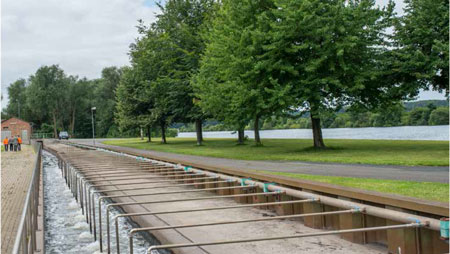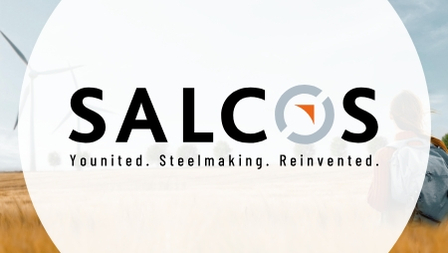The river's source is the mill
29.11.2017 | Salzgitter Flachstahl GmbH

Steelworkers need three things: ore, coal and – water! To cool the plants and to quench the steel and slag.
Not far from Germany's Harz Mountains, deep under the town of Börßum, is a large gravel pool that enriches the water with minerals as it flows underground. A first well was drilled at the deepest point in 1938. Today the Salzgitter Flachstahl GmbH (SZFG) waterworks draws water from 80 wells at depths up to 65 m.
In addition to its own plant, the waterworks supplies drinking and service water to commercial customers such as MAN, Alstom and VW in the Salzgitter Watenstedt industrial area.
The water pumped through the Börßum-Heiningen waterworks is deacidified, filtered and disinfected before two parallel pressure lines take it to the Adersheim treatment plant. Here the system boosts the pressure of the drinking water portion before distributing it, while groundwater from the SZFG plant is added to the service water. Because the groundwater under the plant must be continually lowered, this water is also available. In 2016 a total of 2.83 million m³ or some 748 million gallons was pumped. Finally, the water is softened with the help of lime so that the industrial companies can use it as service water. This step produces calcium carbonate slurry, which is returned to the earth as certified fertilizer.
An iron and steel works that draws it water from the depths of the earth with so much effort instead of simply taking it from a river understandably carefully economizes with this resource. To save water, it is therefore treated and reused as much as possible in Salzgitter. The raw material water is therefore possibly the best symbol for reduce, reuse, recycle.
No one knows how this works better than Cord Strathmann. The civil engineer has worked at SZFG since 1989 as the head of TZW Wasserversorgung und Abwasseranlagen (water supply and sanitation facilities water technology center). As water protection officer, he has recorded the impressive figures for the water carousel in Salzgitter.
For example, in 2016 the recirculation flow rate, which is the amount of water moved in the companies' circulation per year was 512.62 million m³ (roughly 135,420 million gallons). The larger portion, 77% or 396.11 million m³ (104,641 million gallons) is needed as cooling water, and the rest is used as process water in production. Then comes the figure that really makes Cord Strathmann proud. "The loss, or the fresh water that has to be added to the circuits, is only 2.51 percent!"
The pipe losses throughout the entire system were only 2.48% in 2016. In 2006, this figure was still 11.7%. Responsible for this are the "physical and commercial losses", terms that refer to the difference between the amount conveyed and the amount delivered. They result from measuring errors, the filter rinse water in the Börßum waterworks, reading tolerances, unpaid consumption and actual leakages.

In spite of all the recirculation steps, there is naturally still waste water. In 2016 the Salzgitter Flachstahl central wastewater treatment plant discharged 12.5 million m³ (3302 million gallons), which was less than in the previous year. This is an example of how the cycle closes again for the water that is used in Salzgitter.
The process starts with mechanical cleaning. A coarse screen system removes all solids larger than 10 mm from the drain water. The next step is the primary sedimentation tank, where further solids settle while the light substance that gather on the surface are cleared away.
Now the waste water is introduced to completely different, and above all hungry, creatures: A pumping station pumps it into the biological cleaning step, where bacteria dig in to the remaining substances.
But before this, process waste water from the coking plant, sludge water from the slurry treatment plant, street runoff and cleaning water that do not require mechanical cleaning and a few other ingredients that make life pleasant for the bacteria are mixed in with the waste water.

This mixture collects in the first aeration tank into which air is constantly blown. "We must always maintain optimal living conditions for the various types of bacteria," explains Dirk Nowak, Wasserversorgung und Abwasseranlagen SZFG.
The microorganisms' metabolism biologically decomposes the normal pollution, but also phenols and cyanide, as well as nitrogen compounds. These processes continue in additional aeration tanks. There compressed air likewise ensures excess oxygen, and the bacteria are caused to break down nitrates into oxygen and nitrogen due to the removal of oxygen and additional of methanol.
At the end a mixture of water and "activated sludge" collects in two clarifier tanks. Gravity ensures that the heavy bacteria slurry mass deposits and the newly arriving waste water from the mechanical cleaning can be mixed in again. A small, but additional completed cycle.
All that is left behind is the now clean water, which is fed into the small river Aue via the Lahmann Ditches. But what does "fed" mean? The cleaned waste water is an important source of the Aue. And so the mill in Salzgitter is really a river’s source. And it is even so clean, that it meets the strict requirements for swimming.

But why is the cleaned wastewater not simply fed back in to the water supply cycle as service water? Cord Strathmann shakes his head as he explains, "Unfortunately that will not work, because the treatment would be too complex. Service water must fulfill certain requirements so that it does not damage any production plants and is suitable for the manufacture of the highest steel grades."
Instead, another cycle closes: the one from source to source, from Börßum to the Aue – but with the detour for use as service and drinking water in the Salzgitter-Watenstedt industrial area. And a close look shows additional water treatment process that also run in closed circulation. Last year in the sintering furnace, 704 t, including iron-bearing primary sludge, were fed back into smelting and 684 t of biological slurry were sent to the coking plant.
A good result, but one on which the SZFG neither will nor can rest. Because starting in 2021, the company will need a new permit to feed waste water into public waters. This necessitates a long procedure that has already begun. Cord Strathmann and his men are leaving nothing to chance.







